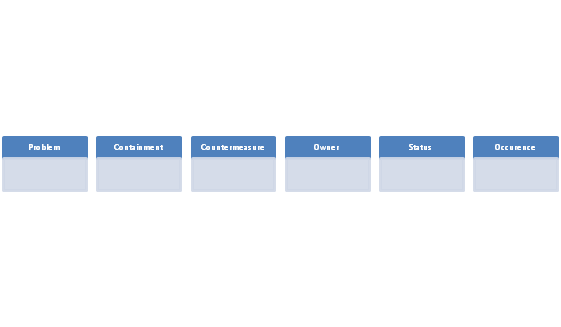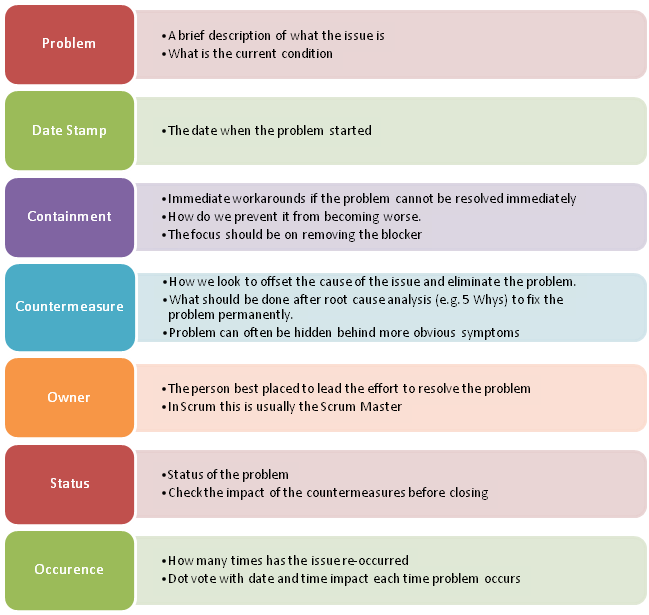Share this
Using a problem countermeasure board to overcome repeating agile development impediments
by Anthony Boobier on 23 August 2011
When identifying impediments or issues on an agile development project, I’m struck by that Yogi-ism “It’s Déjà vu all over again”. Teams can be so focussed on resolving an issue and then rapidly moving on, that they don’t take stock as to why the problem occurred in the first place; what was the root cause? Retrospectives are a good way to deal with problems in agile projects, if we can remember the problems that occurred during an iteration and if indeed they were the real issue.
Impediments
In agile development projects, the key is to identify and resolve impediments within a local project team as quickly as possible. An impediment or issue is anything that prevents a team from performing their work as effectively as possible, something that could prevent or delay delivery of the product. In Scrum the mechanism to log and monitor these is the Impediments backlog, or Issues or Blockers list.
Each team member has a specific opportunity to identify impediments during the daily Scrum meeting. It is improtant that specific blocked tasks or features, along with more general problems that have been identified are made visible to all. When there's a problem, write it up on the board. Making problems explicit encourages us to deal with them; If it’s not visible it can’t be a problem.
The Scrum Master is charged with ensuring impediments get resolved, taking pressure off the team so that (as Don Reinersten comments) they can feel “If you’re going to worry about it I won’t!”. The role of the Scrum Master should be not just to own and remove these impediments (where practical), but also to diagnose problems, ensure the implementation of countermeasures and assess their effectiveness.
Continuous Improvement
Why wait till the retrospective to look at problem solving for any impediments raised during an iteration? Why not look to continuously Improve organisational policies and procedures. All too often Scrum teams look for local project optimatzation and then teams have to re-learn when a ne w project comes along. While it is good to remove a problem, it’s even better to prevent it from occurring again; even it’s for another team.
Problem Countermeasure board
Mary and Tom Poppendieck suggest using a Problem Countermeasure board and putting this next to the visual control board for the team. By doing this we can extend the Impediments backlog and enable a leaner approach to continuous imrovement.
The following is Problem-Countermeasure board columns are based on the work ofJason Yip.

Fig 1: Problem Countermeasure Board column headings
Whenever someone identifies a problem they should:
- write it on the board, along with containment or workaround if problem cannot be resolved immediately
- put a block symbol on the team board on the associated task or feature
- date stamp when it first occurred
- find an owner
If an Issue stays around for too long it has a nasty habit of causing problems throughout the whole system, the blocked area also becomes the bottleneck for our system and constrains the flow of work.
Each time the problem re-surfaces, update the Problem-Countermeasure board. Add a flag to indicate it has impacted the team again and by how much time. This approach:
- quantifies the impact of any impediments, along with effectiveness of their associated countermeasures
- validates actual impediments and eliminates those which do not actually exist (but that we though did !)
- prioritises the impediments which are having most impact upon the team

Fig 2: Problem Countermeasure Board content decscriptions
The key focus is to identify what is the root cause of the problem,(e.g. using 5 whys but never stopping at an individual) how can you ensure it will not occur again or manifest itself elsewhere. Don’t close a problem until you have checked the impact of any countermeasures that have been implemented.
Summary
Don’t get stuck in a time loop and solve the same problem over and over again on your agile development projects. Ensure you find the root cause of your problems and implement preventative solutions in a timely manner so “new” impediments don’t give you a feeling of déjà vu…
Share this
- Agile Development (84)
- Software Development (64)
- Scrum (39)
- Business Analysis (28)
- Agile (27)
- Application Lifecycle Management (26)
- Capability Development (20)
- Requirements (20)
- Solution Architecture (19)
- Lean Software Development (17)
- Digital Disruption (16)
- IT Project (15)
- Project Management (15)
- Coaching (14)
- DevOps (14)
- Equinox IT News (12)
- IT Professional (11)
- Knowledge Sharing (10)
- Strategic Planning (10)
- Agile Transformation (9)
- Digital Transformation (9)
- IT Governance (9)
- International Leaders (9)
- People (9)
- IT Consulting (8)
- AI (7)
- Cloud (7)
- MIT Sloan CISR (7)
- ✨ (7)
- Change Management (6)
- Azure DevOps (5)
- Innovation (5)
- Working from Home (5)
- Business Architecture (4)
- Continuous Integration (4)
- Enterprise Analysis (4)
- FinOps (4)
- Client Briefing Events (3)
- Cloud Value Optimisation (3)
- GitHub (3)
- IT Services (3)
- Business Rules (2)
- Data Visualisation (2)
- Java Development (2)
- Security (2)
- System Performance (2)
- Automation (1)
- Communities of Practice (1)
- Kanban (1)
- Lean Startup (1)
- Microsoft Azure (1)
- Satir Change Model (1)
- Testing (1)
- November 2025 (1)
- August 2025 (3)
- July 2025 (3)
- March 2025 (1)
- December 2024 (1)
- August 2024 (1)
- February 2024 (3)
- January 2024 (1)
- September 2023 (2)
- July 2023 (3)
- August 2022 (4)
- July 2021 (1)
- March 2021 (1)
- February 2021 (1)
- November 2020 (2)
- July 2020 (1)
- June 2020 (2)
- May 2020 (2)
- March 2020 (3)
- August 2019 (1)
- July 2019 (2)
- June 2019 (1)
- April 2019 (2)
- October 2018 (1)
- August 2018 (1)
- July 2018 (1)
- April 2018 (2)
- January 2018 (1)
- September 2017 (1)
- July 2017 (1)
- February 2017 (1)
- January 2017 (1)
- October 2016 (2)
- September 2016 (1)
- August 2016 (4)
- July 2016 (3)
- June 2016 (3)
- May 2016 (4)
- April 2016 (5)
- March 2016 (1)
- February 2016 (1)
- January 2016 (1)
- December 2015 (5)
- November 2015 (11)
- October 2015 (3)
- September 2015 (1)
- August 2015 (1)
- July 2015 (7)
- June 2015 (7)
- April 2015 (1)
- March 2015 (2)
- February 2015 (2)
- December 2014 (3)
- September 2014 (2)
- July 2014 (1)
- June 2014 (2)
- May 2014 (8)
- April 2014 (1)
- March 2014 (2)
- February 2014 (2)
- November 2013 (1)
- October 2013 (2)
- September 2013 (2)
- August 2013 (2)
- May 2013 (1)
- April 2013 (3)
- March 2013 (2)
- February 2013 (1)
- January 2013 (1)
- November 2012 (1)
- October 2012 (1)
- September 2012 (1)
- July 2012 (2)
- June 2012 (1)
- May 2012 (1)
- November 2011 (2)
- August 2011 (2)
- July 2011 (3)
- June 2011 (4)
- April 2011 (2)
- February 2011 (1)
- January 2011 (2)
- December 2010 (1)
- November 2010 (1)
- October 2010 (1)
- February 2010 (1)
- July 2009 (1)
- October 2008 (1)